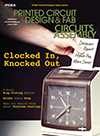Products
EFD, www.efd-inc.com/components.html
The ImageWriter, for in‑system programming, can program final application code or localized content into the device.
Data I/O, www.dataio.com
Includes algorithms designed to bring greater image clarity to low-contrast components, for better defect analysis. The image clarity results in lower false-call rates and improved defect detection.
Is ergonomically advanced with significant user and system interfaces. Can be deployed in a 2-D paste, pre-reflow, mixed-mode and post-reflow environment while quickly converting the optics head for inline 3-D solder paste inspection.
Links to downstream repair stations and statistical process control.
Agilent Technologies, www.agilent.com/see/aoi.
"Trunk" routing functionality, within P.R.Editor XR, can now swap equivalent pins quickly and easily to improve routability. The report generator, post drill files, DXF post processing, general menu and tool bars have been made more user friendly. Back annotation function has been enhanced to make file transfer from PCB design into the schematic smoother and simpler.
Cadstar SI Verify, which offers a complete post-layout signal integrity simulation toolset with seamless integration into Cadstar, also features many new functions for ease of use and accuracy. This includes upgrades to the via modelling function, to provide more in-depth analysis details and user defined n-port circuit models to take into account components such as filters and ferrite beads. Both of these enhancements are also supported by Scenario Editor, a “what-if” simulation scratch pad.
Zuken, zuken.com
Handles such packages as MSOP, SOIC, PLCC, SSOP and TSSOP.
A tray-only version will be available at a later date.
BPM Microsystems, www.bpmmicro.com.
Also, coverage of the Ultra 850G system has been expanded to wire bond and die placement inspection. Flying Color Technology has been added to broaden the defect coverage and lower false rejects.
Machine Vision Products, www.machinevisionproducts.com.
RoHS/WEEE compliant.
Microscan, microscan.com
Handling ranges to 01005 placement capability (0402 in metric) and up to 33.5 mm sq. The LNC60 laser align sensor, which includes laser-centering placement capability
for most 1.27 mm pitch BGAs and an optional placement load control, can measure six parts simultaneously. Step motors control the input
and output buffer conveyors, enhancing speed. Data, feeders, nozzles and floor trolleys are interchangeable with other Juki lines. Comes standard with a new axes control system, which means more motors
on the pick-and-place head but fewer cables. Conforms to RoHS.
Juki Corporation, jas-smt.com
The release offers improved integration with the enterprise, as well as improved design productivity and 'what if' signal integrity analysis. New feature include:
- Library and data management -- Tighter integration with DMS and added functionality to provide off-the-shelf RoHS design-for-compliance capabilities.
- Constraint editor system -- Addition of electrical rules entry, layout and analysis functionality to complement the high-speed physical rules already provided.
- Signal integrity verification -- Addition of the newly released ICX Pro Explorer functionality to the flow, Mentor's high-speed constraint development tool.
- Design layout -- Significant productivity enhancement capabilities including additional support for layout of flex boards; trace glossing so designers can more closely control interactive routing on dense designs; hard and soft autorouting "fences" to help control routing around dense BGAs as opposed to through them resulting in higher routing completion rates; additional gate and pin swapping capabilities to optimize layout.
- FPGA-on-Board -- Improved integration of I/O Designer to accommodate high pin count, high performance FPGA implementation.
Mentor Graphics, mentor.com
Also new is Amkor's tsMLF (Thin Substrate
Micro LeadFrame-TAPP), a sub-100 micron flip chip test die, and
the redesigned Cookson, Indium and AIM print test boards and kits.
Also new is Amkor's CVBGA very thin ChipArray BGA.
- Automated site prep (scavenging) system that permits fully automatic, component removal, noncontact, site prep, and placement of components with minimum operator intervention.
- Automatic and vision assisted placement, which facilitates precision placement of high lead count components such as Cu-CGAs. The system uses machine vision components and software to reduce cycle times and, improve yields. The system can be fully manual or manual with visual assist to allow fast and accurate placement of components that, without this benefit, are difficult to align.
- Wide area profile storage compatibility, which permits central storage of processes and profiles. During runtime, the system checks for the most updated profile through the network and downloads the latest process file on demand or automatically. This allows a central process lab to always maintain and distribute the latest data globally.
- New bottom heater and motorized table, including a 4.0 or 5.6 kW bottom heater designed for Pb-free processes. Also new to this table design is the ability to have a bottom heater cooling boost that decreases cycle times and meets maximum time above liquidus constraints.
- Integrated technical documentation. All manuals, help files, schematics and knowledgebase troubleshooting are imbedded in the SierraMate 7.0 application software. This allows operators and engineers to access all information about the machine locally. All GUI documentation, screens, help files and reports can be localized into native languages to ease in new operator learning.
vjelectronix.com
Market drivers such as OEM requests for process traceability, conversion to Pb-free electronics and more are compelling electronics manufacturers to move from a manual spot check routine to automatic and continuous monitoring of their reflow process. The software provides full process traceability in thousands of installations around the world, along with automatic profiling and SPC charting.
Version 2.3.0.0 is free of charge to all customers.
KIC, kicthermal.com
Press Releases
- E-tronix Hosts Webinar with Laser Wire Solutions CEO on Advancing Medical Manufacturing Through Laser Technology
- Niche Electronics Completes Transition to Enhanced Leadership Team
- Aegis Software Expands its Presence in France and Partners with STPGroup
- Altus Adds Breakthrough Automated Inline Laser Depaneling System to its Line-Up


